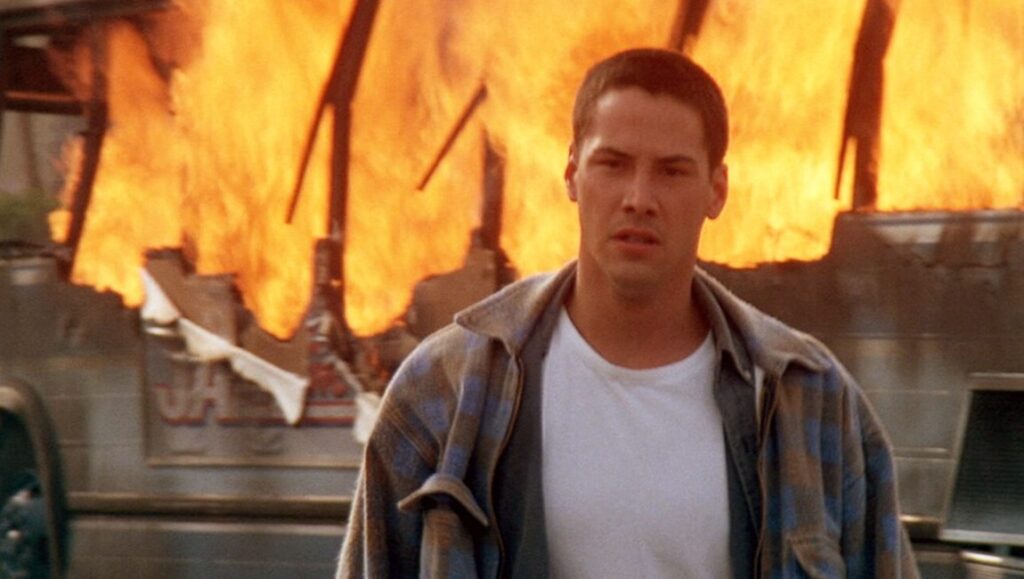Pop quiz, hotshot: if a city bus is rigged with explosives and speeding down the highway at 50mph, what is the probability that Keanu Reeves and Sandra Bullock are on board? This is the basic plot of Jan de Bont’s 1994 Speed, an action thriller that’s almost caveman-esque in its primal simplicity: go fast or go boom. Reeves stars as Jack Traven, a member of the LAPD bomb squad who’s having a very bad day, though it’s not all terrible. Over the course of the world’s worst commute, he falls for a girl-next-door type named Annie (Sandra Bullock), who helms the wheel of a cursed city bus despite having her license suspended for, you guessed it, speeding. de Bont and writer Graham Yost fully buy into this preposterous but undeniably thrilling premise, enlisting Dennis Hopper as Howard Payne, a vengeful ex-cop who was fired before he could start collecting his pension, and who now seeks to make himself whole by any means necessary. With nothing to lose, his retirement plan is now to hold innocent passengers ransom in order to secure a handsome payout.
Though the speeding bus makes up the bulk of the film’s action, it opens with a somewhat slower set piece, at least in terms of mileage, if not suspense. A stalled express elevator in a high-rise office building has trapped a dozen-odd passengers at the 30th floor, who are held for $3M ransom. Traven and his partner Harry (Jeff Daniels) deduce that it’s rigged with explosives and that the perpetrator is riding the freight elevators to stay on the scene. After a couple of terrifying drops, they manage to evacuate the very shaken passengers and evade a hostage situation. Thwarted, Payne detonates a bomb in the building parking lot, leading the LAPD to believe he’s been neutralized. Of course, he was just biding his time; never get between a civil servant and his pension.
Once Payne re-emerges and alerts Traven about his new plan to make public transit more efficient, the story truly kicks into overdrive. From there, it’s nonstop action as Traven figures out how to get on the bus in the first place and deals with another batch of horrified passengers. Meanwhile, Annie plows through cars both parked and in motion in order to stay above 50mph, LAPD choppers circle overhead to clear their path, and Harry works the files back at HQ to figure out their perp’s identity. Throughout, there’s an almost Hitchcockian level of suspense at play, since any passenger who tries to escape will also trigger the bomb. Most passengers ride out this commute from hell in varying states of panic or disbelief, though some, like Annie, try to stay cool under pressure (this was tough for many reasons: years later, Bullock and Reeves separately confessed to crushing on each other on set). Her sarcastic quips and the deadpan commentary provided by small-town yokel tourist Stephens (Alan Ruck) provide some levity even through the film’s most thrilling scenes, like the famous jump over a 50-foot highway gap.
While Speed is de Bont’s first time in the director’s chair, he had already earned his action bona fides as DP for Die Hard, leading fans and critics alike to call his debut feature “Die Hard on a bus.” They’re not wrong, per se, but Speed’s execution is what earns it a spot alongside other genre classics from the era, like James Cameron’s Terminator 2: Judgment Day. America’s crumbling social safety net is as worthy an antagonist as killer robots, and the “lone wolf domestic terrorist” narrative is chillingly believable here, coming as it did just a year before the 1995 Oklahoma City bombing.
By the time Annie drives the bus to LAX, where they buy time by circling the mercifully clear runways, viewers might be suffering from the sort of movie anxiety most recently associated with the Safdie brothers (should we start referring to Good Time as “Speed in Queens”?) But just because the bus is finally dispatched, in a bevy of explosions that makes Michael Bay look like the picture of restraint, doesn’t mean Payne is done trying to fund his golden years. The third act shifts underground as he, Traven, and Annie make their way to a speeding subway car, blowing through half-finished tunnels before skipping the rail and skidding to a stop on the pavement. There, at long last, they’ve arrived at their destination: a well-earned make-out session amidst the wreckage. Stand clear of the closing doors, kids.


Comments are closed.